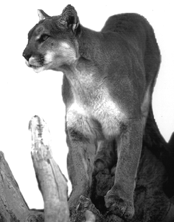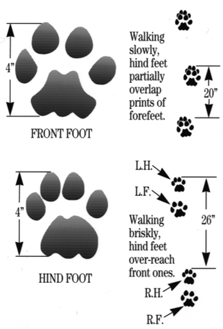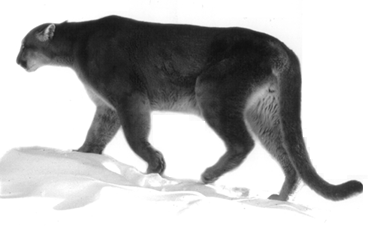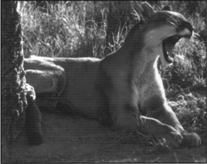|
Publications
Safety
Guide to Cougars
Printed February, 1996
British Columbians are fortunate to share their province with cougars, one of the most
mysterious and elusive of all creatures. The cougar's secretive habits and astounding
predatory abilities - a cougar is capable of killing a 270 kg (600 lb) moose - have
resulted in a wealth of misconceptions and irrational fears.
Actually, most British Columbians live all their lives without a glimpse of a cougar,
much less a confrontation with one. Conflict between cougars and humans is extremely rare.
In the past 100 years, a total of five people have been killed by cougar attacks in B.C.
(in comparison, bees kill upwards of three Canadians every year). All but one of these
fatal cougar attacks occurred on Vancouver Island. During the same period, there were 29
non-fatal attacks in British Columbia - 20 of which occurred on Vancouver Island. The vast
majority of these attacks were on children under the age of 16.
Although a cougar attack is highly unlikely, it always pays to be prepared. Information
and awareness are your best defenses.
About Cougars:

- The cougar, also called mountain lion or panther, is Canada's largest cat. Cougars have
long tails which may be one-third of their total body length.
- An adult male cougar weighs between 63 and 90 kg (140-200 lbs), and a female cougar,
between 40 and 50 kg (90-120 lbs). The biggest cougars are found in the interior and the
Kootenays.
- The cougar's primary prey is deer. It will also feed on wild sheep, elk, rabbits,
beaver, raccoons, grouse, and occasionally livestock.
- Cougars are most active at dusk and dawn. However, they will roam and hunt at any time
of the day or night and in all seasons.
- During late spring and summer, one to two-year old cougars become independent of their
mothers. While attempting to find a home range, these young cougars may roam widely in
search of unoccupied territory. This is when cougars are most likely to conflict with
humans.
Tracks:
- Cougars have four toes with three distinct lobes present at the base of the pad. Claws
are retractable, so they usually do not leave imprints.
- Generally, cougars are solitary. If tracks show two or more cougars traveling
together, it probably indicates a female with kittens.

When in Cougar Country:
Cougars primarily occupy the southern third of British Columbia.
Most conflict with cougars occurs in rural communities, where
people live in isolated settlements. People also encounter cougars
while spending leisure time in cougar country.
Cougars are predators - the top of the food chain - and their actions are often
unpredictable. We have little understanding about what might trigger an attack, but
following these general guidelines will reduce the risk of cougar conflict and prepare you
in the unlikely event of an attack.
Children:
Cougars seem to be attracted to children, possibly because their high-pitched voices,
small size, and erratic movements make it difficult for cougars to identify them as human
and not prey.
- Talk to children and teach them what to do if they encounter a cougar.
- Encourage children to play outdoors in groups, and supervise children playing outdoors.
- Consider getting a dog for your children as an early-warning system. A dog can see,
smell, and hear a cougar sooner then we can. Although dogs offer little value as a
deterrent to cougars, they may distract a cougar from attacking a human.
- Consider erecting a fence around play areas.
- Keep a radio playing.
- Make sure children are home before dusk and stay inside until after dawn.
- If there have been cougar sightings, escort children to the bus stop in the early
morning. Clear shrubs away around the bus stop, making an area with a nine-metre (30 foot)
radius. Have a light installed as a general safety precaution.
Your yard and home:
- Do not attract or feed wildlife, especially deer or raccoons. These are natural
prey and may attract cougars.
Pets:
- Roaming pets are easy prey.
- Bring pets in at night. If they must be left out, confine them in a kennel with a secure
top.
- Do not feed pets outside. This not only attracts young cougars but also many small
animals, such as mice and raccoons, that cougars prey upon.
- Place domestic livestock in an enclosed shed or barn at night.
Hiking or working in cougar country:
- Hike in groups of two or more. Make enough noise to prevent surprising a cougar.
- Carry a sturdy walking stick to be used as a weapon if necessary.
- Keep children close-at-hand and under control.
- Watch for cougar tracks and signs. Cougars cover unconsumed portions of their kills with
soil and leaf litter. Avoid these food caches.
- Cougar kittens are usually well-hidden. However, if you do stumble upon cougar kittens,
do not approach or attempt to pick them up. Leave the area immediately, as a female will
defend her young.

If you meet a cougar:
- Never approach a cougar. Although cougars will normally avoid a confrontation,
all cougars are unpredictable. Cougars feeding on a kill may be dangerous.
- Always give a cougar an avenue of escape.
- Stay calm. Talk to the cougar in a confident voice.
- Pick all children up off the ground immediately. Children frighten easily and
their rapid movements may provoke an attack.
- Do not run. Try to back away from the cougar slowly. Sudden movement or flight
may trigger an instinctive attack.
- Do not turn your back on the cougar. Face the cougar and remain upright.
- Do all you can to enlarge your image. Don't crouch down or try to hide. Pick up
sticks or branches and wave them about.
If a cougar behaves aggressively:

- Arm yourself with a large stick, throw rocks, speak loudly and firmly. Convince the
cougar that you are a threat not prey.
- If a cougar attacks, fight back! Many people have survived cougar attacks by
fighting back with anything, including rocks, sticks, bare fists, and fishing poles.
Cougars are a vital part of our diverse wildlife. Seeing a cougar should be an exciting
and rewarding experience, with both you and the cougar coming away unharmed. However, if
you do experience a confrontation with a cougar or feel threatened by one, immediately
inform the nearest office of the Conservation Officer service.
|